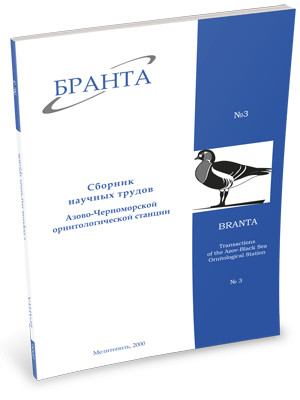
Transactions
of the Azov-Black Sea Ornithological Station



About wintering of Great Bustard in the South of Ukraine in January 2000.
Andryushchenko Y.A., Gorlov, P.I., Grinchenko A.B., Oleinik D.S., Prokopenko S.P.
To monitor wintering population of Great Bustard (Otis tarda) counts of the birds were carried out in the south of Kherson region, south-west of Zaporizhzhya region and in the Eastern Crimea (Kerch peninsula). The area was searched by three off-road cars by 20x20 km squares. A total of 3590 birds were counted during the survey. Taking into account the information collected from local people, at least 4273 Great Bustards were wintering in the area of the survey.
The majority of birds were concentrated in two places: 1931 individuals in SE of the Kherson region (Novotroitzki district) and around 1000 individuals in the Kerch peninsula. Small flocks were predominant: 21.9% out of the total number of flocks recorded consisted of 2-9 birds, in 37.5% of cases the flock size ranged from 14 to 47 birds. Nevertheless, the majority of Great Bustards was concentrated in large flocks from 332 to 1000 birds (12.5%). Sex of 442 Great Bustards in 22 flocks was identified. Sex ratio turned out to be female-biased - 205:237. Eleven flocks consisted of males only, one mixed flock was recorded. Sex ratio in this mixed flock - 1 male/2.5 females. Great Bustards tended to keep to the fields of winter crops (32.4% of flocks and 11.1% of individuals), stubble of grasses (26.5% and 36.2% flocks and individuals correspondingly). The lucerne fields and fallow lands were less attractive for them (8.8% of flocks, 7.6-14.2% of individuals). Mortality of Great Bustards wintering in the south of Ukraine is related to colliding with the electric transmission lines, shooting by hunters, catching of birds, which lost ability to fly due to icing of the feathers, poisoning by pesticides, and starvation.
Read the paper in a PDF file